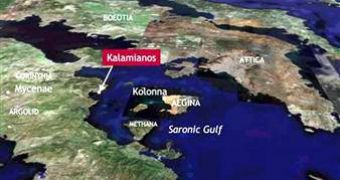If you've enjoyed "Troy", then you could be interested by the fact that archaeologists have discovered a possible place from where Troy's attackers set out. Daniel Pullen, an archaeologist at the Florida State University, first found the ruins in 2001 and recently presented his findings at the annual meeting of the Archaeological Institute of America in January 2008.
The spectacularly preserved ancient city harbor belonged to the Mycenaean civilization, which many ancient Greek legends, including that of Troy, were based. Even being 3,500 years old, hundreds of walls are still in their original position. Over 900 walls were counted. The ancient city is partially underwater along a rocky, isolated shoreline and could have been a military outpost.
"It is rare indeed to locate an entire town built during the Late Bronze Age that shows this level of preservation," said Pullen.
Most Mycenaean towns are now completely covered by dirt and sediments deposed over thousands of years. "Usually to excavate Mycenaean buildings you have to dig underground. What we have here is the plan of an entire town preserved for us. We have the fortification wall, we have all these buildings, and we can often see where the doorways would be. We can see how the buildings relate to each other, because we have obvious alleyways and streets," Pullen told LiveScience.
Most walls are aligned, pointing that the city was built all at once, not gradually over time, when a random arrangement of buildings results.
"We have evidence that there were a few people at this site for a long time before. Then at some particular point people came in and established this as a new outpost or maybe a naval or military base. And they brought their engineers and builders with them and constructed the main part of the site all at once," said Pullen.
Mycenean warriors
No agricultural signs at the site strengthens the idea of a military/naval outpost at the Korphos-Kalamianos settlement. The site is located on the shore of the Saronic Gulf (western Aegean Sea) about 60 mi (100 km) southwest of Athens, and about 40 mi (65 km) east of Mycenae, the largest Mycenaean city. The Mycenaean civilization flourished in southern Greece from 1600 to 1100 B.C., being wiped out later by the invasion of new Greek tribes. The building Korphos-Kalamianos occurred shortly before the dating of the Troy War. The Myceneans were mainly farmers and shepherds, ruled by a warrior class of nobles.
"There were a number of wealthy nobles beneath the king who owned land and were involved in various economic activities. The majority of people were involved in agriculture. We know from the Mycenaean tablets that the palace was very interested in sheep to produce wool for fine textiles, and they produced lots of olive oil and lots of wine for feasts," said Pullen.
No palace was found at Korphos-Kalamianos, but many building had palace-style architecture, thus they were inhabited by nobles or officials.
"Perhaps the site was an official outpost of the palace at Mycenae," said Pullen, who tried to explain the unusual preservation of the city.
"Perhaps earthquake activity shook off most of the land covering the ruins over the years. Or maybe farming in the area caused soil to erode, leaving the buildings exposed," Pullen hypothesized .
Underwater measurements will be made to determine the coastline during the Late Bronze Age, the age of Korphos-Kalamianos. This could have been an attractive natural harbor.

 14 DAY TRIAL //
14 DAY TRIAL //